Abstract
Accurate measurements and predictions of near-surface soil drying and evaporation following heavy rainfall events are often needed for research in agriculture and hydrology. However, such measurements and predictions at mine waste pile and tailing settings are limited. The prediction of evaporation at mine waste piles is essential for many problems in geotechnical engineering, including the design of soil cover systems for the long-term closure of hazardous waste sites, and thus mitigates, for example, the generation of acid mine drainage (AMD) and metal leaching. AMD is one of mining’s most serious threats to the environment. This study investigated the short-term (8 days) and medium-term (27 days) drying rates and evaporative fluxes at the surface and near-surface of the Deilmann South waste-rock (DSWR) pile at the Key Lake uranium mine, northern Saskatchewan, using the gravimetric (GV) method and SoilCover (SC) model, respectively, during and following heavy rainfall events for the environment. The SC simulation results showed that during the weather-controlled stage (Stage I) of the first 5-day period of rainfall events, while the surface was wet, the potential evaporation (PE) was equal to the actual evaporation (AE) (i.e., AE/PE = 1). As the surface became drier on Day 6, the cumulative PE began to separate from the cumulative AE and the surface’s drying rate rapidly diverged from those at the deeper depths. This occurrence signaled the onset of the soil profile property-controlled stage (Stage II). As the drying continued, the surface became desiccated and the slow-rate drying stage (Stage III) was established from Day 7 onward. The SC-simulated AE results were compared to those measured using the eddy covariance (EC) method for the same test period at the DSWR pile in a different study. The comparison showed that the two methods yielded similar AE results, with 18% relative errors. The results of this study provided the opportunity to validate the SC model using actual data gathered under field conditions and to ascertain its ability to accurately predict the PE and AE at the surfaces of mine waste piles.
1. Introduction
Accurate measurements and predictions of surface and near-surface soil drying and evaporation are critical in designing soil cover systems for mine waste rocks and tailings. However, such measurements and predictions regarding waste-rock and tailing settings are limited [1,2,3,4,5,6,7,8,9,10,11,12]. Soil covers over mine waste-rock dump tops are intended to limit the ingress of oxygen and/or to limit the net percolation of rainfall infiltration into the underlying potentially reactive waste rock [13,14,15,16,17,18,19]. Also, the upward movement of oxidation products or process water constituents is controlled when cover is used. AMD is one of mining’s most serious threats to the environment. The appropriate type of soil cover depends mainly on the nature of the waste and the climate in which the waste is located. There is a significant need to understand the mechanisms that govern the infiltration and evaporation of rainwater from the surface of waste-rock and tailing settings [20]. Surface conditions control the production of leachate from mine waste dumps. Soil water evaporation occurs under unsteady conditions and results in a net water loss from the soil, i.e., drying. Net water fluxes are a function of the infiltration entering the soil cover due to atmospheric evaporation. Measurements of soil surface drying and evaporation are critical since the interface between the surface and atmosphere is the boundary of mass and energy exchanges where most radiation is absorbed, reflected, and emitted; mass is exchanged through evaporation, condensation, and precipitation [20,21]. Fluctuations in water content due to heavy precipitation events or long drying periods greatly affect the water content profile, affecting the gas diffusion and redistribution in the unsaturated zones [2]. Precipitation can create changes in soil water content profiles within unsaturated zones; the extent of the effect will depend on the intensity and duration of the rainfall [22,23]. Water ingress is affected by geological structures and the characteristics of the aquifer, drainage pattern, and precipitation frequency [24,25,26]. The prediction of evaporative fluxes under these conditions is required in the design of soil cover systems. Since both climatic conditions and soil properties control the actual rate of evaporation, accurate prediction of the natural rate of evaporation from soil surfaces requires a method of analysis that includes both factors. Numerically simulating the water balance across the air–soil interface is one avenue being considered to provide boundary conditions for simulations of deeper flows [20]. The micrometeorological technique of the eddy correlation has been used to measure heat, momentum, and water vapor fluxes for over 30 years [27].
An alternative approach to short-term evaporation measurements is the Penman [28] method, often referred to as a combination method, as it calculates the potential rate of evaporation based on combining the heat budget with the Dalton equation for evaporation. SoilCover 2000 [29] is a model developed for designing and analyzing multi-layered soil covers over mine tailings/waste rocks/municipal waste facilities. It uses a modified Penman formulation proposed by Wilson [20], valid for any analysis requiring the computation of actual surface fluxes based on soil conditions and climatic data. Scanlon et al. [9] compared water balance simulation results from seven codes: HELP, HYDRUS1D, SHAW, SoilCover, SWIM, UNSAT-H, and VS2DT. Simulation results from most of the codes were similar and generally reproduced measured water balance components at the Texas and Idaho sites.
The objective of this study was to investigate the drying rates and evaporation on the surface and near the surface of the DSWR pile following heavy rainfall events and to validate and ascertain the ability of the SC model to accurately predict the AE by comparing the field results to those obtained using the more complex EC technique.
2. Study Site
This field study was conducted on the DSWR pile at the Key Lake uranium mine in northern Saskatchewan, Canada (57°12′ latitude, 105°35′ longitude), as indicated in Figure 1, Figure 2 and Figure 3. The DSWR pile has been previously used for measuring CO2 and O2 [2,30,31,32] and evaporation using the EC [1].
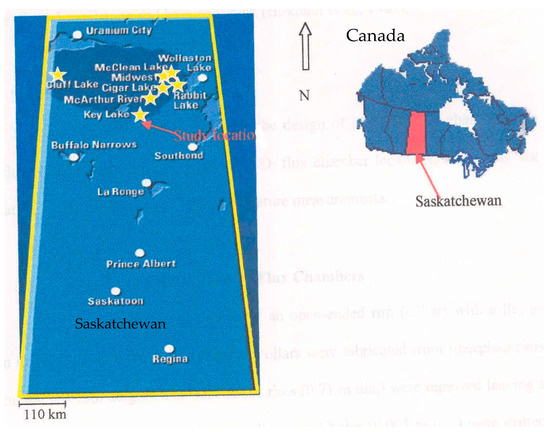
Figure 1.
Maps showing the study site in the province of Saskatchewan and the county of Canada.

Figure 2.
Photograph showing the weather station and Eddy covariance (EC) sensors on the Deilmann South (DSWR) waste-rock pile.
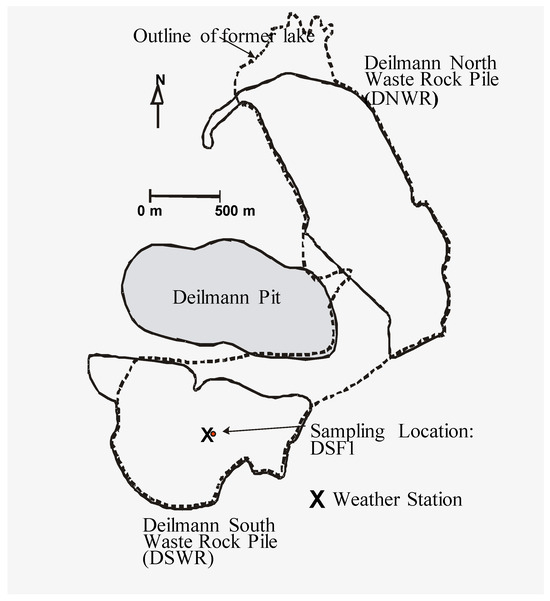
Figure 3.
Map showing the Deilmann South (DSWR) and North (DNWR) waste-rock piles, the Deilmann pit, and a weather station.
The annual precipitation averages 481 mm of water, equivalent with 321 mm of rainfall. June, July, and August are the wettest months, receiving ca. 45% of the annual precipitation [1]. The DSWR pile was made from overburden sand excavated during open-pit mining between 1984 and 1997 [33]. The DSWR pile has a total volume of about 20 million m3 and a maximum height of about 28 m [31]. The ground preparation and placement of the excavated overburden sand are described in [31,33]. A weather station was installed at the DSWR pile to measure the daily weather data.
Borehole logs from the DSWR pile (Figure 4) are described in [31]. Results indicate that the DSWR pile is sandy throughout its depth [31]. More information on the gas and pore water geochemistry of the DSWR pile can be found in [31,32] and Lee et al. [34].

Figure 4.
The DSWR pile depth profiles of (a) geology, (b) volumetric moisture content, (c) oxygen concentration, and (d) CO2 concentration [31].
3. Methodology
3.1. Particle-Size Distribution (PSD)
Weathered waste-rock material for particle-size distribution (PSD) was collected from the surface and near the ground surface (0 to 0.15 m) of the DSWR pile at location DSF1 (Figure 2). The PSD was determined following the ASTM 2007 [35] procedure for the standard particle-size analysis of soils.
3.2. Soil Water Characteristic Curve (SWCC)
The soil water characteristic curve (SWCC) is the relationship between the water content and matric suction of an unsaturated soil. In this study, the SWCC for the DSWR sample was determined in a Plexiglas Tempe cell apparatus (0.1 m dia. × 0.14 m height) using the standard method of ASTM [36,37] that provides a discussion on the measurement of the matric suction. The Tempe cell is commonly used to measure the entire SWCC for sand and silt material with low air entry values (AEVs) (<500 kPa). This technique, however, is time-consuming and requires several weeks or months to complete the test. The AEV defines the minimum matric suction at which air starts to enter the largest pores in the soil as it desaturates. In the traditional Tempe procedure, the slurried sample is confined in the cell and the air pressure is applied overtop. Then, the water content reaches a new equilibrium when the change in the cell’s mass becomes stable at each suction step. The water released from the soil is collected at the base of the cell. Higher pressure steps are applied until the maximum suction is reached. After reaching the final equilibrium, the moisture content is measured by oven-drying. This water content, together with the previous changes in mass, is used to back-calculate the water contents corresponding to the other suction values. The matric suctions are then plotted against their corresponding water contents to yield the SWCC.
3.3. Gravimetric Soil Water Content
The water content for all samples obtained in the field was determined using the gravimetric method (ASTM D2216-19) [38]. Waste-rock samples were collected at different depths (0, 0.05, 0.10, and 0.15 m) in triplicates of about 100 g each at three locations around DSF1 (Figure 2). The samples were placed in zippered, air-tight plastic bags. Gravimetric water contents were determined in the laboratory at the Key Lake mine by oven-drying the waste-rock sample within 24 h. The replicate measurements were combined to yield a mean water content value for each depth. The waste-rock samples were collected daily during the 8-day test period (29 July to 6 August 2002).
3.4. SoilCover (SC) Model
SoilCover (SC) [29,39] is probably the most widely used code for designing soil covers for waste-rock dumps and tailings impoundments. SC is a one-dimensional finite element package that models transient conditions. The model uses a physically based method for predicting the exchange of water and energy between the atmosphere and a soil surface. The SC model calculates actual evaporation from a soil profile based on the coupled heat and mass flow governed by the meteoric and soil conditions. The theory of SC is based on the well-known principles of Darcy’s and Fick’s Laws, which describe the flow of liquid water and water vapor, and Fourier’s Law, which describes conductive heat flow in the soil profile below the soil/atmosphere boundary. SC predicts the evaporative flux from a saturated or unsaturated soil surface based on atmospheric conditions, vegetation cover, and soil properties. A modified Penman formulation calculates the evaporation rate from the soil/atmosphere boundary [39].
where:
E = Vertical evaporative flux (mm/day);
Γ = Slope of the saturation vapor pressure versus temperature curve at the mean temperature of the air;
Q = Net radiant energy available at the surface (mm/day);
ν = Psychrometric constant;
Ea = f(u)Pa(B − A);
f(u) = Function dependent on wind speed, surface roughness, and eddy diffusion = 0.35(1 + 0.1Ua);
Ua = Wind speed (km/h);
Pa = Vapor pressure in the air above the evaporating surface;
A = Inverse of the relative humidity of the air = 1/ha;
B = Inverse of the relative humidity at the soil surface = 1/h.
The modified Penman formulation accounts for net radiation, wind speed, and the relative humidity of both the air and soil surface while calculating the evaporation from an unsaturated soil surface.
3.5. Eddy Covariance (EC) Technique
This research study did not use the Eddy covariance (EC) technique to measure evaporation. Still, it was used in a different study by [1] on the DSWR pile during the same test period (Figure 2 and Figure 3). Therefore, there was no need to duplicate the EC study. The EC data obtained by [1] were used for comparison with those obtained using the SC model. The details of the EC method and data analysis are described in [1]. The EC technique measures the flux of a scalar (heat, CO2, H2O) or momentum at a point centered on an instrument placed at some height (on the weather station, Figure 3) above the ground surface.
The EC measurements can be challenging to interpret. When the source of fluxes is influenced by a heterogeneous landscape or during stable or weakly turbulent periods (i.e., usually at nighttime), the flux footprint might cover areas beyond the scope of the landscape of interest [40,41]. Another critical issue regarding the EC method is the assumption that adjective fluxes can be ignored; however, such conditions are common over multiple landscapes, such as heterogeneous irrigated agricultural regions [42]. The sum of the components of the energy balance is often not zero and this imbalance can make up 10 to 40% of the net radiation [43]. Advective conditions tended to increase the magnitude of the energy imbalance; thus, the uncertainties of the surface fluxes derived by the EC method are less reliable in these cases.
In summary, Carey et al. [1] used the EC technique to continuously measure turbulent fluxes (LνE and H) where E is evaporation, Lv is the latent heat of evaporation, and H is convective sensible heat exchange. Wind speed and gas concentration measurements and their fluctuations were obtained at 10 Hz [4]. Both LvE and H were calculated as the product of the mean covariance of the vertical wind speed fluctuations (w′) and the scalar fluctuations in water vapor density (ρv′) and temperature (T′), as described by [44]:
where Ca is the heat capacity of air and the prime symbol (′) denotes the deviation from the mean.
Two important assumptions are made: (a) air density fluctuations are assumed to be negligible and (b) mean vertical flow is assumed to be negligible for horizontal homogeneous terrain (no divergence/convergence).
4. Results
4.1. PSD
Figure 5 shows the PSD for the sample collected near the ground surface (0–0.15 m) at the DSWR pile (broken line with symbols) [2]. The mean ± one standard deviation of 106 grain-size distributions obtained from core samples from the DSWR pile [31] are also presented in the figure. The PSD for the material was within the envelope of the core samples (solid lines, ±standard deviations). The PSDs of waste-rock samples were not representative of the entire DSWR pile as boulder-sized particles were excluded from the analysis [2]. The testing of waste mine burden/waste-rock interferences can be found in [45,46,47].
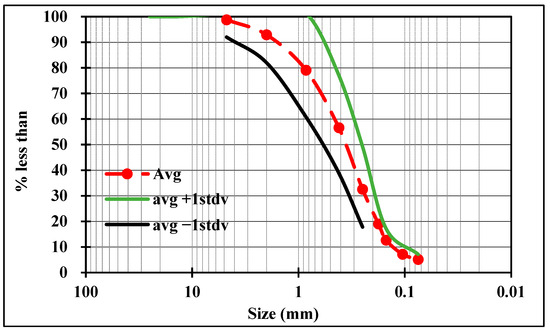
Figure 5.
Particle-size distribution of a sample from the DSWR pile (broken line) with ± standard deviations (solid lines) of 106 samples.
4.2. SWCC
Figure 6 shows the volumetric and gravimetric SWCCs for the sample collected at the DSWR pile measured using the Tempe cell, as described in Section 3.2 [48]. The symbols represent the measured data (0.2 to 100 kPa) and the solid lines represent the best-fit curves extended to 1,000,000 kPa suction, generated using Fredlund and Xing [49].
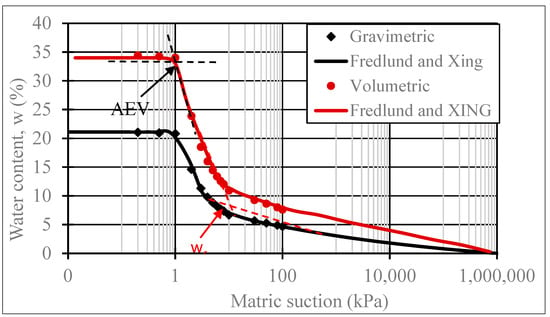
Figure 6.
Volumetric and gravimetric soil water characteristic curves (SWCCs) for the DSWR pile samples. The intersections of the tangent dashed lines on the curve represent the AEV and residual water content wr.
4.3. Weather Station Data at the DSWR Pile
Table 1 presents the weather data (rainfall, temperature, relative humidity, radiation, and wind speed) measured during the 8-day test period (29 July to 5 August 2002) using a weather station installed at the DSWR pile [5].

Table 1.
Weather data from the weather station at the DSWR pile.
Table 1 indicates that from Day 1 to Day 2, 75.8 mm of rainfall fell on the DSWR pile. It should be noted that this is an extreme amount of precipitation for the environment, representing 24% of its annual rainfall. There is a gradual decrease in rainfall intensity from 7 mm to 0.4 m following the 48 h of heavy rain up to Day 5. There was no rainfall recorded from Day 6 to Day 8. The air temperature data showed a decreasing trend (from 12 to 7 °C) during the rainfall events and an increasing trend (from 7 to 15 °C) following the cessation of the rainfall up to the end of the test period on Day 8. The relative humidity (RH) and net radiation varied between 70 and 95% and 20 and 65 W/m2, respectively, over the 8-day test period. The wind speed ranged between 3.1 and 8.3 m/s over the same test period.
4.4. Short-Term Measurements of the Soil Drying Rates by the Gravimetric Method following Heavy Rainfall Events at the Surface and Near-Surface of the DSWR Pile
Figure 7 shows changes in soil water profiles (0–15 cm) with time over an 8-day test period at the DSWR pile. The rainfall events data are also plotted in the same figure illustration.
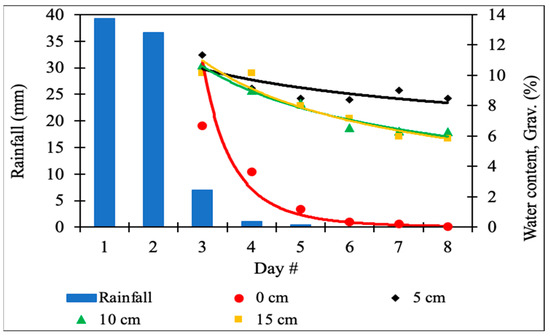
Figure 7.
Rainfall and gravimetric water contents were measured over an 8-day test period at the DSWR pile.
There were no water content measurements during the initial 48-h period of heavy rainfall and the soil surface (0 cm) visually appeared wet (saturated). On Day 3, the measured soil water content values of all of the deeper depths were close to 11%, except for the soil surface (0 cm), which dropped to about 6.5% on Day 3.
From Day 3 to Day 5, as the rainfall intensity continued to diminish gradually to about 1 mm on Day 5, the surface water content rapidly diverged (decoupled) from those at deeper depths and decreased to about 0.5% on Day 5 while the deeper-depths soil water content values remained elevated (6–8%) (Figure 7). From Day 5 to Day 8, no rainfall was recorded and a large vertical gradient in water content was formed as the surface water content fell to a very low value of <0.1%.
4.5. Prediction of Potential and Actual Evaporation Rates Using the SoilCover Model during and following Heavy Rainfall Events for the 8-Day and 27-Day Test Periods at the DSWR Pile
Figure 8 shows the cumulative potential (PE) and actual (AE) evaporation data predicted by the SC model (SoilCover 2000) for the 8-day test periods at the DSWR pile; it is plotted along with the rainfall events and surface (0 cm) water content for illustration purposes. Figure 9 presents the three different stages (I, II, III) of the normalized drying rates, AE/PE, for the 8-day test period. Figure 10 and Figure 11 present the cumulative PE and AE data predicted by the SC for the 27-day test period and subsequent rainfall events occurred between Days 8 and 10 and Days 16 and 22 of the test periods, respectively.
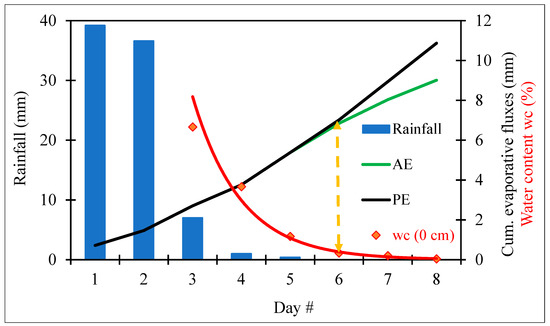
Figure 8.
Rainfall, PEs, and AEs predicted by SoilCover (SC) and water content measured at the DSWR pile. The yellow dashed line illustrates the separation point of PE and EA and its corresponding value of surface water content.
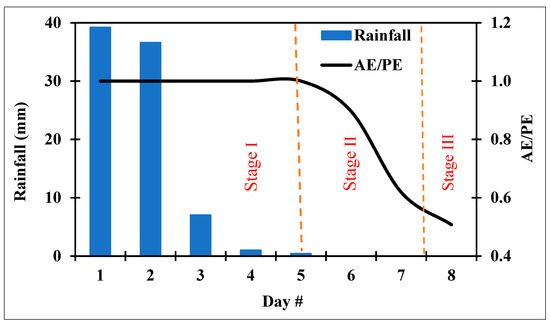
Figure 9.
Rainfall and the ratio of AE/PE predicted by SoilCover (SC) at the DSWR pile.
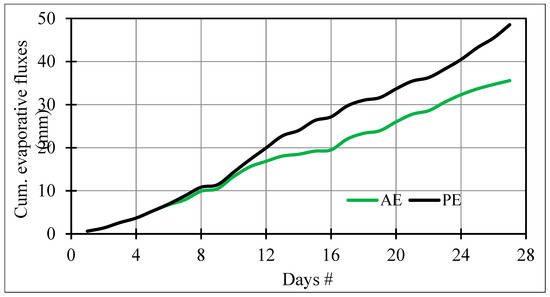
Figure 10.
Cumulative potential (PE) and actual (AE) evaporations predicted by SoilCover at the DSWR pile.
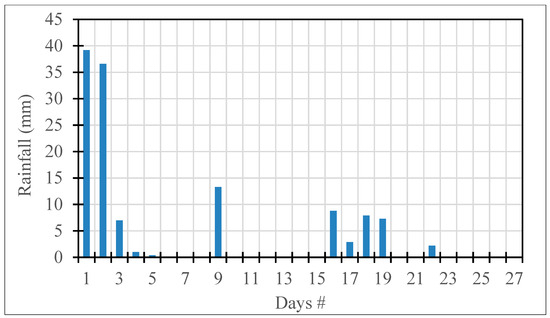
Figure 11.
Rainfall events during the 27-day test period at the DSWR pile.
4.6. Comparison of SoilCover-Simulated AE Data with Eddy-Covariance-Measured AE Data during the 8-Day and 27-Day Test Periods at the DSWR Pile
Near-continuous measurements of the AE at the DSWR pile were obtained by [1] in a different study using the EC technique (broken lines in Figure 12 and Figure 13) during the 8-day and 27-day test periods. These measured AE data, obtained using the EC technique, were then used in this study to compare with those obtained using the SC model simulations of AE data (solid lines in Figure 12 and Figure 13).
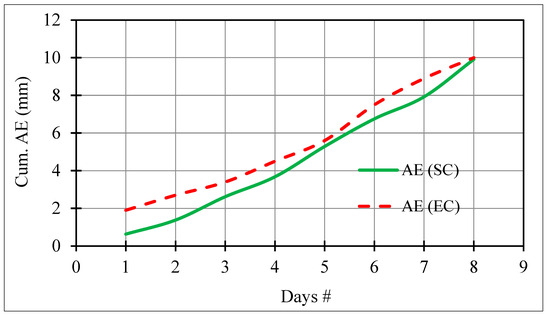
Figure 12.
Cumulative actual evaporations (Aes) measured using the eddy covariance (EC) technique and predicted by the SoilCover (SC) model at the DSWR pile.
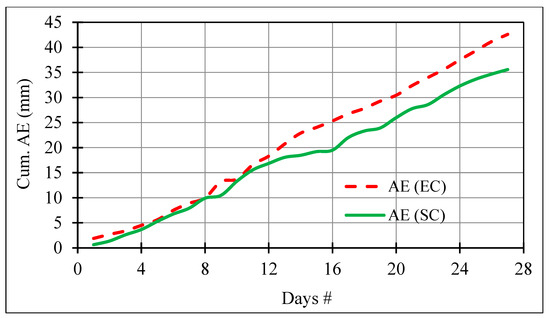
Figure 13.
Cumulative actual evaporations (Aes) measured with the eddy covariance (EC) technique and predicted with the SoilCover (SC) model at the DSWR pile.
Figure 14 shows the relationships between the SC-predicted AE and EC-measured AE data.
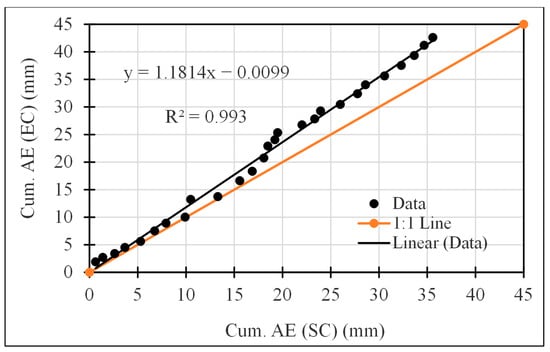
Figure 14.
Relationships between actual evaporations (AEs) measured with the eddy covariance (EC) technique and predicted evaporations measured with the SoilCover (SC) model.
5. Discussion
5.1. PSD
The PSD in Figure 5 indicates that 90% of the material was sand-sized, with 10% silt- and clay-sized particles. The uniformity coefficient Cu (Cu = D60/D10) of the sample is about 3. Note that Cu < 4 indicates a uniformly graded material having a narrow range of particle sizes. It can be concluded that the sand material tested is uniformly graded (D60 Sieve opening size (mm), through which 60% of aggregate passes, and D10 Sieve opening size (mm), through which 10% of aggregate passes).
These results agree with those of the borehole logs from the DSWR presented in Figure 4 [31]. Borehole logs from the DSWR pile (Figure 4) indicate that the DSWR pile is sandy throughout its depth. This sandstone of the Athabasca region is readily broken down during mining and placement and the pile is texturally uniform, consisting of unsaturated fine- to medium-grained sand (Figure 2).
5.2. SWCC
The volumetric and gravimetric SWCCs for the DSWR are shown in Figure 6. The key features of the SWCCs are the AEV and the residual degree of saturation [49]. The AEV of the sample was determined graphically, as shown in Figure 6 (the point of intersection of the two tangents drawn from the SWCC). From the SWCCs, the soil sample from the DSWR pile would likely remain saturated or nearly saturated to a negative pressure (AEV) of only up to 1 kPa. The sample drained rapidly between values of matric suctions of 1 and 100 kPa. At 10 kPa, the sample retained about 11% and 8% residual volumetric and gravimetric water content, respectively. Carey et al. [1] indicated a 30% infiltration of precipitation at the surface of the DSWR pile. This behavior is characteristic of sand and sand/silt materials. The shape of the SWCC depends largely upon texture (i.e., PSD) and structure, which determine the ability of the soil to store water. It should be noted that the Tempe cell SWCC is based on a single measurement with little or no consideration of the experimental error in the collection of SWCC data by the operator. Systematic or experimental errors in the SWCC measurements increase uncertainty [50]. Newer devices for SWCC measurement, such as HYPROP, rely on the evaporation method described by [51,52,53]. The HYPROP is automated, allowing non-stop operation, which shortens the overall testing time to a few days and restricts human input during the measurement.
5.3. Short-Term Measurements of the Soil Drying Rates by the Gravimetric Method following Heavy Rainfall Events at the Surface and Near-Surface of the DSWR Pile
Figure 7 shows that as the rainfall intensity continued to diminish gradually to reach its lower value, the surface water content rapidly diverged (decoupled) from those at deeper depths and a large vertical gradient in water content was formed while the deeper-depth soil water content values remained elevated (6–8%) (Figure 7). This rapid drop in surface water content is due to the texture of the surface, which is a controlling factor for soil moisture [54]. This behavior is also described by [11]: “once the shallow drying layer is formed, the rate of drying increases near the surface and decreases below the drying layer at depths as shallow as 50 mm, thereby capping the water loss in the soil and reducing soil evaporation”. This process, which they call decoupling, results in the drying rates in the two layers becoming linearly correlated, as is also shown in Figure 7.
5.4. Prediction of Evaporative Fluxes Using the SoilCover Model during and following Heavy Rainfall Events at the DSWR Pile
The simulation results in Figure 8 and Figure 9 show that the AE was equal to the PE (or AE/PE = 1) during the first five days of the test period while the soil surface was saturated/near-saturated. This is a constant-rate drying stage (Stage I), also referred to as the weather-controlled stage, during which the evaporation rate is controlled by atmospheric forcing conditions, such as temperature and relative humidity. As the soil surface became drier (i.e., 0.2% water content (wc, 0 cm)) after Day 5, following the cessation of rainfall, the AE started falling below the PE. This drop signaled the transition between the weather-controlled stage (Stage I) and the soil-profile-controlled stage (Stage II) (Figure 8). At this stage, the evaporation rate is limited or dictated by the rate at which the gradually drying soil profile can deliver moisture toward the evaporation zone [20]. This behavior is caused by the reduction of the hydraulic conductivity due to the decrease in the surface water content as it evaporates. As drying continues, a residual slow-rate drying stage is established (Stage III), i.e., from Day 7 onward (Figure 8). At the end of the 8-day test period, the SC-simulated results yielded cumulative PE and AE of 11 and 8 mm/day, respectively (Figure 7). The SC simulation results of the extended test period of 27 days (Figure 8) yielded a cumulative PE and AE of 49 and 36 mm, respectively. These field data results illustrate the capability of predictions of AE by the SC model.
5.5. Comparison of SoilCover-Simulated Data with Eddy-Covariance-Measured Data during and following Heavy Rainfall Events at the DSWR Pile
Figure 12 compares the AEs predicted by SC and those measured using EC methods. The results indicate that the EC consistently plotted slightly above SC during the 8-day test period. At the end of the test period, the EC measured an accumulation AE of 10 mm. In contrast, SC yielded comparable data, with an overall cumulative AE of 9.9 mm, about 1% lower than that measured by the EC technique. These results illustrate the capability and accuracy of predictions of AE by the SC model.
Figure 13 compares the results of the cumulative AEs predicted by SC and those measured using the EC over the extended period of 27 days at the DSWR pile. Figure 13 shows that the two methods yielded comparable results in the early measurements up to Day 12. From Day 12 onward, the EC consistently plotted above the SC. At the end of the 27-day test period, the EC and SC yielded cumulative AEs of 43 and 35, respectively, with a relative error of 18% between the two values. Figure 14 shows the relationship between SC and the EC. The slope indicated that the EC overestimated the AE by 18% for the 27-day test period data. Though not excessively large, these differences presumably reflect the different processes measured by the two methods.
It should be noted that, typically, the EC underestimates scalar fluxes (H and LvE), resulting in a significant residual flux density [1]. In the study carried out by [1] at the DSWR pile, H, and LvE were corrected for underestimation by the EC by adjusting for energy balance. Moreover, the EC measurements are not perfect due to assumptions, physical phenomena, instrument problems, and the specifics of the terrain and setup [41]. Fluxes could be over- or underestimated if errors are not prevented during the design and setup or not corrected during data processing.
Though more expensive and technically more complex, the EC method is a powerful tool for the near-continuous, long-term monitoring of the AE fluxes but does not measure the PE.
6. Summary and Conclusions
In this field study carried out at the DSWR pile at the Key Lake uranium mine, the SC model was used to demonstrate that it is well suited for the predictions of PE and AE at mine waste piles. The SC model accurately predicted the PE and AE of the surface of the DSWR pile during and after heavy rainfall events over a test period of 8 days. The results showed that the AE/PE = 1 during the weather-controlled stage (Stage I) and AE/PE < 1 as the surface became drier during the soil profile and residual slow-rate drying stages (Stages II and III, respectively).
The cumulative AEs for the 8-day and 27-day test periods predicted by SC were compared to those measured using the EC technique for the same test period in a different study. The two methods were comparable, with 18% relative errors. Though more expensive and technically more complex, the EC method provides a powerful tool that allows for the near-continuous, long-term monitoring of the AE flux but does not measure the PE flux that is predicted by SC. Thus, it was concluded that both the EC and SC models are well-suited to the measurements and predictions of evaporation fluxes associated with mine waste dumps. These two methods provide information of a complementary nature that can significantly improve our understanding of the evaporation at mine waste dumps. The results of this research study can be helpful for geotechnical engineers and practitioners working on the design and monitoring of soil cover systems for the long-term closure of hazardous waste sites and, thus, mitigate the generation of AMD, which is one of mining’s most serious threats to the environment.
Author Contributions
Methodology, Investigation, writing original draft preparation, L.K.K.; reviewing editing, supervision, W.G.W. All authors have read and agreed to the published version of the manuscript.
Funding
Funding for this research was provided through an Industrial Research Council grant from Cogema Resources Ltd., Cameco Corporation, and the Natural Sciences and Engineering Research Council of Canada.
Data Availability Statement
The data presented in this study are available on request from the corresponding author. The data are not publicly available due to intellectual property.
Acknowledgments
Sean Carey is acknowledged for providing the EC data and valuable suggestions. The authors would also like to thank Sharon Harper for editing and proofreading the manuscript.
Conflicts of Interest
The authors declare no conflict of interest.
References
- Carey, S.K.; Barbour, S.L.; Hendry, M.J. Evaporation from a waste-rock surface, Key Lake, Saskatchewan. Can. Geotech. J. 2005, 42, 1189–1199. [Google Scholar] [CrossRef]
- Kabwe, K.L.; Wilson, G.W.; Hendry, J. Effects of rainfall events on the surfaces of two waste-rock piles. Environ. Eng. Sci. 2005, 4, 469–480. [Google Scholar] [CrossRef]
- Meier, D.E.; Barbour, S.L. Monitoring of Cover and Watershed Performance for Soil Covers Placed over Saline-Sodic Shale Overburden from Oilsands Mining. In Proceedings of the National Meeting of the American Society of Mining and Reclamation, Lexington, KY, USA, 9–13 June 2002; ASMR: Lexington, KY, USA, 2002. [Google Scholar] [CrossRef]
- Shurniak, R.; Babour, S.L. Modeling of Water Movement Within Reclamation Covers on Oilsands Mining Overburden Piles. In Proceedings of the National Meeting of the American Society of Mining and Reclamation, Lexington, KY, USA, 9–13 June 2002. [Google Scholar] [CrossRef]
- Reedy, R.C.; Scanlon, B.R. Long-Term Water Balance Monitoring of Engineered Covers for Waste Containment. In Proceedings of the International Containment and Remediation Technology Conference, Orlando, FL, USA, 10–13 June 2001; Institute for International Cooperative Environmental Research, Florida State University: Tallahassee, FL, USA, 2002; p. 73. Available online: https://www.iicer.fsu.edu (accessed on 16 September 2023).
- Baalousha, H.M.; Ramasomanana, F.; Fahs, M.; Seers, T.D. Measuring and Validating the Actual Evaporation and Soil Moisture Dynamic in Arid Regions under Unirrigated Land Using Smart Field Lysimeters and Numerical Modeling. Water 2022, 14, 2787. [Google Scholar] [CrossRef]
- Rianna, G.; Reder, A.; Pagano, L. Estimating actual and potential bare soil evaporation from silty pyroclastic soils: Towards improved landslide prediction. J. Hydrol. 2018, 562, 193–209. [Google Scholar] [CrossRef]
- Lehmann, P. Surface evaporative capacitance: How soil type and rainfall characteristics affect global-scale surface evaporation. J. Water Resour. Res. 2019, 55, 519–539. [Google Scholar] [CrossRef]
- Scanlon, B.R.; Christman, M.; Reedy, R.C.; Gross, B. Intercode comparisons for simulating water balance in an engineered cover. In Proceedings of the 2001 International Containment and Remediation Technology Conference, Orlando, FL, USA, 10–13 June 2002; Institute for International Cooperative Environmental Research, Florida State University: Tallahassee, FL, USA, 2002; p. 148. [Google Scholar]
- Barbour, S.L.; Boese, C.; Stolte, B. Water balance for reclamation covers on oilsands mining overburden piles. In Proceedings of the Canadian Geotechnical Conference, Canadian Geotechnical Society, Calgary, AB, Canada, 16–19 September 2001; pp. 313–319. [Google Scholar]
- Capehart, W.J.; Carlson, T.N. Decoupling of surface and near-surface soil water content: A remote sensing perspective. J. Water Resour. Res. 1997, 33, 1383–1395. [Google Scholar] [CrossRef]
- Capehart, W.J.; Carlson, T.N. Estimating near-surface soil-moisture availability using a meteorologically driven soil water profile model. J. Hydrol. 1994, 160, 1–20. [Google Scholar] [CrossRef]
- Pabst, T.; Molson, J.; Bussière, B. Comparative performance of cover systems to prevent acid mine drainage from pre-oxidized tailings: A numerical hydro-geochemical assessment. J. Contam. Hydrol. 2017, 214, 39–53. [Google Scholar] [CrossRef]
- Albright, W.; Benson, C.; Apiwantragoon, P. Field Hydrology of Landfill Final Covers with Composite Barrier Layers. J. Geotech. Geoenviron. Eng. 2013, 139, 1–12. [Google Scholar] [CrossRef]
- Rahardjo, H.; Santoso, V.; Leong, E.; Ng, Y.; Hua, C. Performance of an Instrumented Slope Covered by a Capillary Barrier System. J. Geotech. Geoenviron. Eng. 2012, 138, 481–490. [Google Scholar] [CrossRef]
- Albright, W.H.; Apiwantragoon, P.; Shackelford, C.D.; Benson, C.H.; Bohnhoff, G.L.; Ogorzalek, A.S. Field Data and Model Predictions for a Monolithic Alternative Cover. ASCE 2008, 135, 1–16. [Google Scholar]
- Wilson, G.W. The application of cover systems for mine closure—Are we doing it right? In Proceedings of the 1st International Seminar on Mine Closure, Perth, WA, Australia, 13–15 September 2006; pp. 31–42. [Google Scholar]
- Aubertin, M.; Molson, J.; Bussiere, B.; Dagenais, A.M. Investigations of layered cover acting as oxygen barriers to limit acid mine drainage. In Proceedings of the 5th ICEG Environmental Geotechnics: Challenges and Responsibilities for Environmental Geotechnics, Cardiff, UK, 26–30 June 2006; Thomas, H.R., Ed.; Thomas Telford Publishing: London, UK, 2006; Volume 2, pp. 827–835. [Google Scholar]
- Aubertin, M.; Aachib, M.; Authier, K. Evaluation of diffusive flux through covers with a GCL. Geotext. Geomembr. 2000, 18, 215–233. [Google Scholar] [CrossRef]
- Wilson, G.W.; Fredlund, D.G.; Barbour, S.L. Couple soil-atmosphere modeling for soil evaporation. Can. Geotech. J. 1994, 31, 151–161. [Google Scholar] [CrossRef]
- Gray, D.M. Handbook on the Principle of Hydrology; Canadian National Committee for the International Hydrological Decade, NRC of Canada: Ottawa, ON, Canada, 1970. [Google Scholar]
- Dunkerley, D. Effects of rainfall intensity fluctuations on infiltration and runoff: Rainfall simulation on dryland soils, Fowlers Gap, Australia. Hydrol. Process. 2011, 26, 2211–2224. [Google Scholar] [CrossRef]
- Stone, J.J.; Paige, G.B.; Hawkins, R.H. Rainfall intensity-dependent infiltration rates on rangeland rainfall simulator plots. Trans. ASABE 2008, 51, 45–53. [Google Scholar] [CrossRef]
- Khan, J.; Ahmed, W.; Waseem, M.; Ali, W.; Rehman, I.u.; Islam, I.; Janjuhah, H.T.; Kontakiotis, G.; Bathrellos, G.D.; Skilodimou, H.D. Lowari Tunnel Water Quality Evaluation: Implications for Tunnel Support, Potable Water Supply, and Irrigation in Northwestern Himalayas, Pakistan. Appl. Sci. 2023, 13, 8895. [Google Scholar] [CrossRef]
- Chen, Z.; He, C.; Yang, W.; Guo, W.; Li, Z.; Xu, G. Impacts of geological conditions on instability causes and mechanical behavior of large-scale tunnels: A case study from the Sichuan–Tibet highway, China. Bull. Eng. Geol. Environ. 2020, 79, 3667–3688. [Google Scholar] [CrossRef]
- Holmøy, K.; Nilsen, B. Significance of geological parameters for predicting water inflow in hard rock tunnels. Rock Mech. Rock Eng. 2014, 47, 853–868. [Google Scholar] [CrossRef]
- Ff Vendrame, N.; Tezza, L.; Pitacco, A. Comparison of sensible heat fuxes by large aperture Scintillometry and Eddy covariance over two contrasting−climate vineyards. Agric. For. Meteorol. 2020, 288, 108002. [Google Scholar] [CrossRef]
- Penman, H.L. Natural evapotranspiration from open water, bare soil and grass. Proc. R. Soc. Lond. A 1948, 193, 120–146. [Google Scholar]
- SoilCover2000. SoilCover User’s Manual, Unsaturated Soils Group; Department of Civil Engineering, University of Saskatchewan: Saskatoon, SK, Canada, 2000. [Google Scholar]
- Kabwe, K.L.; Farrell, R.E.; Carey, S.K.; Hendry, M.J.; Wilson, G.W. Characterizing spatial and temporal variations in CO2 fluxes from ground surface using three complimentary measurement techniques. J. Hydrol. 2005, 311, 80–90. [Google Scholar] [CrossRef]
- Birkham, T.K.; Hendry, M.J.; Wassenaar, L.I.; Mendoza, C.A.; Lee, E.S. Characterizing geochemical reactions in unsaturated mine waste-rock piles using gaseous O2, CO2, 12CO2, and 13CO2. Environ. Sci. Technol. 2003, 37, 496–501. [Google Scholar] [CrossRef]
- Birkham, T.K. Characterizing Geochemical Reactions in Waste-Rock Piles at the Key Lake Mine using Gaseous Oxygen. Master’s Thesis, University of Saskatchewan, Saskatoon, SK, Canada, 2002. [Google Scholar]
- Kabwe, K.L. Measurements and modelling of gas fluxes in Unsaturated Mine Waste Materials. Ph.D. Thesis, University of British Columbia, Kelowna, BC, Canada, 2007. [Google Scholar]
- Lee, E.S.; Birkham, T.K.; Wassenaar, L.I.; Hendry, M.J. Microbial respiration and diffusive transport of O2, 16O2, and 18O2 in unsaturated soils and geologic sediments. Environ. Sci. Technol. 2003, 37, 2913–2919. [Google Scholar] [CrossRef]
- ASTM D422-63(2007); Standard Test Method for Particle-Size Analysis of Soils. ASTM Standard; ASTM International: West Conshohocken, PA, USA, 1963. [CrossRef]
- ASTM D6836-02 2008; Standard Test Methods for Determination of the Soil Water Characteristic Curve. ASTM: West Conshohocken, PA, USA, 2008. [CrossRef]
- Fredlund, D.G.; Rahardjo, H. Soil Mechanics for Unsaturated Soils; John Wiley & Sons, Inc.: New York, NY, USA, 1993. [Google Scholar]
- ASTM D2216-19; Standard Test Methods for Laboratory Determination of Water (Moisture) Content of Soil and Rock. ASTM: West Conshohocken, PA, USA, 2017. [CrossRef]
- Noel, M.M.; Rykaart, E.M. Comparative Study of Surface Flux Boundary Models to Design Soil Covers for Mine Waste Facilities. In Proceedings of the 6th International Conference on Acid Rock Drainage (ICARD), Cairns, QLD, Australia, 12–18 July 2003. [Google Scholar]
- Bambach, N.; Kustas, W.; Alferi, J.; Prueger, J.; Hipps, L.; McKee, L.; Castro, S.J.; Volk, J.; Alsina, M.M.; McElrone, A.J. Evapotranspiration uncertainty at micrometeorological scales: The impact of the eddy covariance energy imbalance and correction methods. Irrig. Sci. 2002, 40, 445–461. [Google Scholar] [CrossRef]
- Mauder, M.; Cuntz, M.; Drüe, C.; Graf, A.; Rebmann, C.; Schmid, H.P.; Schmidt, M.; Steinbrecher, R. A strategy for quality and uncertainty assessment of long-term eddy-covariance measurements. Agric. For. Meteorol. 2013, 169, 122–135. [Google Scholar] [CrossRef]
- Wilson, K.; Goldstein, A.; Falge, E.; Aubinet, M.; Baldocchi, D.; Berbigier, P.; Bernhofer, C.; Ceulemans, R.; Dolman, H.; Field, C.; et al. Energy balance closure at FLUXNET sites. Agric. For. Meteorol. 2002, 113, 223–243. [Google Scholar] [CrossRef]
- Leuning, R. The correct form of the Webb, Pearman and Leuning equation for eddy fluxes of trace gases in steady and non-steady state, horizontally homogeneous flows. Bound. Layer Meteorol. 2007, 123, 263–267. [Google Scholar] [CrossRef]
- Webb, E.K.; Pearman, G.I.; Leuning, R. Correction of flux measurements for density effects due to heat and water vapour transfer. Q. J. R. Meteorol. Soc. 1980, 106, 85–100. [Google Scholar] [CrossRef]
- Noll, A.D.; Bergstresser, T.W.; Timothy, W.B.; Woodcock, J. Overburden Sampling and Testing Manual; Earthteih and Geochemical Testing Divisions of Energy Center Inc. Contract No. ME 86120; Commonwealth of Pennsyvania, Department of Environmental Resources Bureau of Mining and Reclamation: Harrisburg, PA, USA, 1998. [Google Scholar]
- Handbook for Waste Rock Sampling Techniques. Energy Mines and Resources; CANMET—MSL Division (MEND Project 4.5.1); SENES Consultants Ltd.: Richmond Hill, ON, Canada, 1994. [Google Scholar]
- Kathleen, S.S.; Hageman, P.L.; Ramsey, C.A.; Wildeman, T.R.; Ranville, J.F. Reconnaissance Sampling and Characterization of Mine-Waste Material. In Proceedings of the U.S. EPA Hard Rock Mining 2006 Conference, Tucson, AZ, USA, 14–16 November 2006. [Google Scholar]
- Barbour, S.L. 1998. Nineteenth Canadian Geotechnical Colloquium: The soil-water characteristic curve: A historical perspective. Can. Geotech. J. 1998, 35, 873–894. [Google Scholar] [CrossRef]
- Fredlund, D.G.; Xing, A. Equations for the soil-water characteristic curve. Can. Geotech. J. 1994, 31, 521–532. [Google Scholar] [CrossRef]
- Ronald, B.; Lauren, F. Uncertainty of Soil Water Characteristic Curve Measurements Using an Automated Evaporation Technique. Vadose Zone J. 2017, 16, 1–11. [Google Scholar] [CrossRef]
- Shokrana, M.S.B.; Ghane, E. Measurement of soil water characteristic curve using HYPROP2. MethodsX 2020, 7, 100840. Available online: www.elsevier.com/locate (accessed on 16 September 2023). [CrossRef] [PubMed]
- Schindle, U.; Durner, W.; von Unold, G.; Mueller, I. Evaporation methods for measuring unsaturated hydraulic properties of soils: Extending the measurement range. Soil Sci. Soc. Am. J. 2010, 74, 1071–1083. [Google Scholar] [CrossRef]
- Peters, A.; Durner, W. Simplified evaporation method for determining soil hydraulic properties. J. Hydrol. 2008, 356, 147–162. [Google Scholar] [CrossRef]
- Hillel, D. Applications of Soil Physics; Academic Press, Inc.: New York, NY, USA, 1980. [Google Scholar]
Disclaimer/Publisher’s Note: The statements, opinions and data contained in all publications are solely those of the individual author(s) and contributor(s) and not of MDPI and/or the editor(s). MDPI and/or the editor(s) disclaim responsibility for any injury to people or property resulting from any ideas, methods, instructions or products referred to in the content. |
© 2023 by the authors. Licensee MDPI, Basel, Switzerland. This article is an open access article distributed under the terms and conditions of the Creative Commons Attribution (CC BY) license (https://creativecommons.org/licenses/by/4.0/).